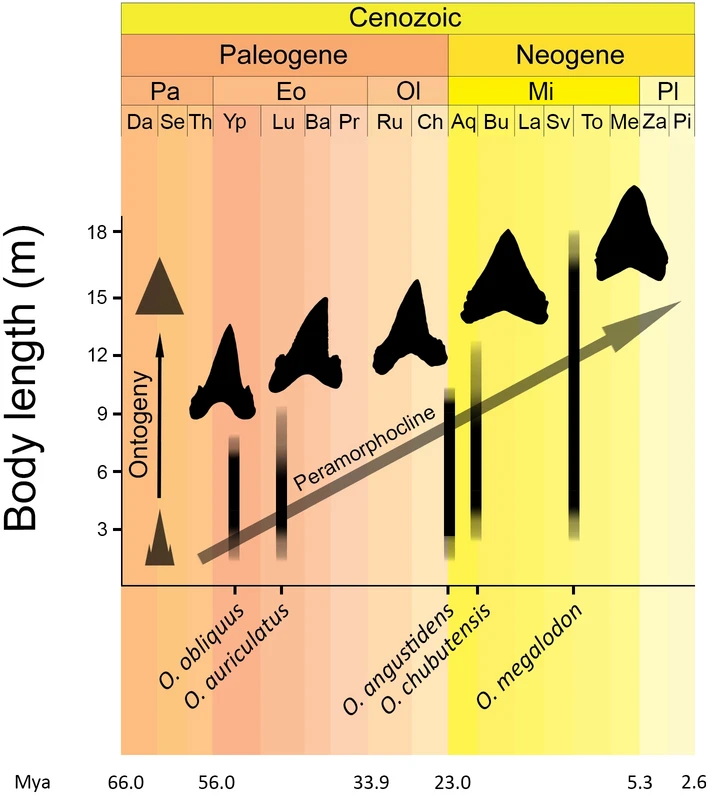|
Megaselachus
''Megaselachus'' is a possibly dubious extinct genus of otodontid shark. In the past, this particular genus has been used to house other otodontids, such as the famous megalodon. It is sometimes considered a subgenus of '' Otodus'', or merged with other related genera such as ''Carcharocles ''Otodus'' is an extinct, cosmopolitan genus of mackerel shark which lived from the Paleocene to the Pliocene epoch. The name ''Otodus'' comes from Ancient Greek (, meaning "ear") and (, meaning "tooth") – thus, "ear-shaped tooth". Descript ...''. The genus lived during the Miocene. Only a single species can be confidentially placed in the genus, '' Megaselachus subauriculatus''. Description ''Megaselachus'' teeth are moderately narrow. They also have a heavily serrated crown. The labial side is convex with a prominent triangular neck, while the lingual side is concave. References {{Taxonbar, from=Q25713052 Otodontidae Miocene sharks Prehistoric shark genera Fossil taxa describ ... [...More Info...] [...Related Items...] OR: [Wikipedia] [Google] [Baidu] |
Megalodon
''Otodus megalodon'' ( ; meaning "big tooth"), Common name, commonly known as megalodon, is an extinction, extinct species of giant mackerel shark that lived approximately 23 to 3.6 million years ago (Mya), from the Early Miocene to the Early Pliocene epochs. ''O. megalodon'' was formerly thought to be a member of the family (biology), family Lamnidae and a close relative of the great white shark (''Carcharodon carcharias''), but has been reclassified into the extinct family Otodontidae, which Speciation, diverged from the great white shark during the Early Cretaceous. While regarded as one of the largest and most powerful predators to have ever lived, megalodon is only known from fragmentary remains, and its appearance and maximum size are uncertain. Scientists have argued whether its body form was more stocky or elongated than the modern lamniform sharks. Maximum body length estimates between based on various analyses have been proposed, though the Mode (statistics), modal ... [...More Info...] [...Related Items...] OR: [Wikipedia] [Google] [Baidu] |
Otodus
''Otodus'' is an extinct, cosmopolitan genus of mackerel shark which lived from the Paleocene to the Pliocene epoch. The name ''Otodus'' comes from Ancient Greek (, meaning "ear") and (, meaning "tooth") – thus, "ear-shaped tooth". Description All species are known from their fossilized teeth, and four of them (''O. obliquus'', ''O. auriculatus'', ''O. angustidens'' and ''O. megalodon'') are also known from their fossilized vertebral centra. Like other elasmobranchs, the skeleton of ''Otodus'' was composed of cartilage and not bone, resulting in relatively few preserved skeletal structures appearing within the fossil record. The teeth of this shark are large with triangular crown, smooth cutting edges, and visible cusps on the roots. Some ''Otodus'' teeth also show signs of evolving serrations. Size estimation The fossils of ''Otodus'' sharks indicate that they were very large macro-predatory sharks. The largest known teeth of ''O. obliquus'' measure about in height. The ... [...More Info...] [...Related Items...] OR: [Wikipedia] [Google] [Baidu] |
Otodontidae
Otodontidae is an extinct family of sharks belonging to the order Lamniformes. Its members have been described as megatoothed sharks. They lived from the Early Cretaceous to the Pliocene, and included genera such as '' Otodus,'' including the giant megalodon ''Otodus megalodon'' ( ; meaning "big tooth"), Common name, commonly known as megalodon, is an extinction, extinct species of giant mackerel shark that lived approximately 23 to 3.6 million years ago (Mya), from the Early Miocene to the Earl .... Recent studies of the newly described genus '' Megalolamna'' indicate that the members of the genus ''Carcharocles'' should be reclassified as members of the genus ''Otodus''. The genus '' Cretalamna'' which lived from the mid-Cretaceous-Paleogene is believed to be directly ancestral to ''Otodus,'' and thus to megalodon. There are certain dubious species of ''Otodontidae'' included species where teeth are not properly described, such as '' Otodus debrayi'', '' Otodus stromeri ... [...More Info...] [...Related Items...] OR: [Wikipedia] [Google] [Baidu] |
Miocene Sharks
The Miocene ( ) is the first geological epoch of the Neogene Period and extends from about (Ma). The Miocene was named by Scottish geologist Charles Lyell; the name comes from the Greek words (', "less") and (', "new") and means "less recent" because it has 18% fewer modern marine invertebrates than the Pliocene has. The Miocene followed the Oligocene and preceded the Pliocene. As Earth went from the Oligocene through the Miocene and into the Pliocene, the climate slowly cooled towards a series of ice ages. The Miocene boundaries are not marked by distinct global events but by regionally defined transitions from the warmer Oligocene to the cooler Pliocene Epoch. During the Early Miocene, Afro-Arabia collided with Eurasia, severing the connection between the Mediterranean and Indian Oceans, and allowing the interchange of fauna between Eurasia and Africa, including the dispersal of proboscideans and hominoids into Eurasia. During the late Miocene, the connections between the ... [...More Info...] [...Related Items...] OR: [Wikipedia] [Google] [Baidu] |
Prehistoric Shark Genera
Prehistory, also called pre-literary history, is the period of human history Human history or world history is the record of humankind from prehistory to the present. Early modern human, Modern humans evolved in Africa around 300,000 years ago and initially lived as hunter-gatherers. They Early expansions of hominin ... between the first known use of stone tools by hominins million years ago and the beginning of recorded history with the invention of writing systems. The use of symbols, marks, and images appears very early among humans, but the earliest known writing systems appeared years ago. It took thousands of years for writing systems to be widely adopted, with writing having spread to almost all cultures by the 19th century. The end of prehistory therefore came at different times in different places, and the term is less often used in discussing societies where prehistory ended relatively recently. It is based on an old conception of history that without ... [...More Info...] [...Related Items...] OR: [Wikipedia] [Google] [Baidu] |




